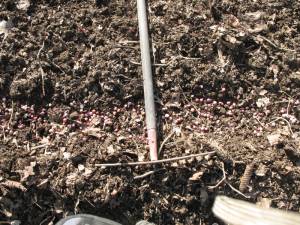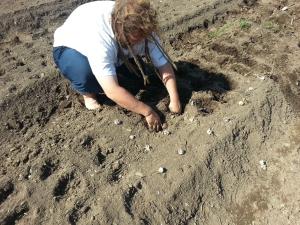![[Snakeroot Organic Farm logo]](pix/sof.gif)
At dawn
Canoe bow waves are quickly lost
on the shoreside
But go on out of sight
on the lake side.
-1986
The constant swish-swish of skis
On a day long ski.
The constant swish-swish of wiper blades
On a day long drive.
-1990
My dog, trotting barefoot
Steps on a garden slug
And thinks
Nothing of it.
-1999
Word spreads quickly
as I approach the pond.
All becomes quiet.
-1997
Hidden in the vines
a large warted cucumber
jumps out of reach.
A toad!
-1997
Delicate puffs
of marshmallow snow
carefully perched
on a branch,
await the trigger of my hat
to melt their way down my back.
-2010
Deep in the tomato jungle
Fruits of yellow, purple and red
Tell of their readiness
To go to market.
-2010
Sugarin' Chores
Snowflakes hurry through my flashlight beam,
As my boots knead new snow with spring mud,
On my nightly Hajj to keep the boil alive,
For as long as possible until the dawn,
To match the power of the flowing sap,
With my meager evaporator and will.
The prize at the finish line are jars of syrup
And Spring.
-2013
Planting Bulbils By Cluster
by Tom Roberts, December, 2013
Click on photos to enlarge.
This is an interim report about an alternate method of bulbil planting that we are developing that we call the “Whole Cluster Method”. We began this project in 2012. If you grow rounds by planting your bulbils this way, we would love to hear about your experiences.
 In the fall of 2012 after we had planted the last of our two 300 foot beds of garlic bulbils in our usual way, we decided to try planting a few more of them as whole clusters of bulbils, that is, without breaking up the clusters at all before planting them. We understood that this would result in the growing bulbils being apparently crowded, but we were interested to see how the bulbils would respond. To ameliorate crowding somewhat, we spaced the bulbil clusters six inches apart in the row, with the rows also six inches apart. After all, we reckoned, this is how nature would do it, alowing over-mature garlic stalks to tip over, thus leaving the clusters of bulbils to sprout on the ground.
In the fall of 2012 after we had planted the last of our two 300 foot beds of garlic bulbils in our usual way, we decided to try planting a few more of them as whole clusters of bulbils, that is, without breaking up the clusters at all before planting them. We understood that this would result in the growing bulbils being apparently crowded, but we were interested to see how the bulbils would respond. To ameliorate crowding somewhat, we spaced the bulbil clusters six inches apart in the row, with the rows also six inches apart. After all, we reckoned, this is how nature would do it, alowing over-mature garlic stalks to tip over, thus leaving the clusters of bulbils to sprout on the ground.
The following July when the tops of the rounds were tiping over (“When the scapes are ready, the rounds go down.”), we harvested the two beds planted our regular way, and took note of bulbil size and percentage that produced micro bulbs with their own scapes. Then we looked at the 20 foot bed of cluster-planted bulbils for comparison. What we discovered surprized us. Not only were the rounds just as big as from bulbils planted the regular way, but there was only one in the entire twenty feet that produced a micro-bulb.

Given these encouraging results, in the fall of 2013 we planted all of our bulbils via the whole cluster method, planting two 300 foot beds with four rows per bed. Both the between-row spacing and the in-row spacing was about eight inches.
January, 2016. Belatedly I can report that the whole-cluster planting technique did not work for us very well at all. Our July 2014 rounds harvest from our October 2013 bulbil cluster planting was one of our poorest ever. For some reason that we have not been able to determine, many of the cluster sites produced only one or two sprouts and some produced none at all. As a result, we have gone back to the bulbils-sprinkled-thickly-into-a-furrow method we had been employing previously.
Nevertheless, it seems the whole-cluster planting method might still be a good idea. We've yet to continue experimenting with it, but should in the fall of 2016.
To see where garlic fits into our rotation scheme, visit our Crop Rotations page. You mighty also like to visit:
 27 Organic Farm Road, Pittsfield Maine 04967 http://www.snakeroot.net/farm owned and operated by Tom Roberts & Lois Labbe Tom: Tom@snakeroot.net (cell) 207-416-5417 or Lois: Lois@snakeroot.net (cell) 207-416-5418 Gardening for the public since 1995. |
|
|

